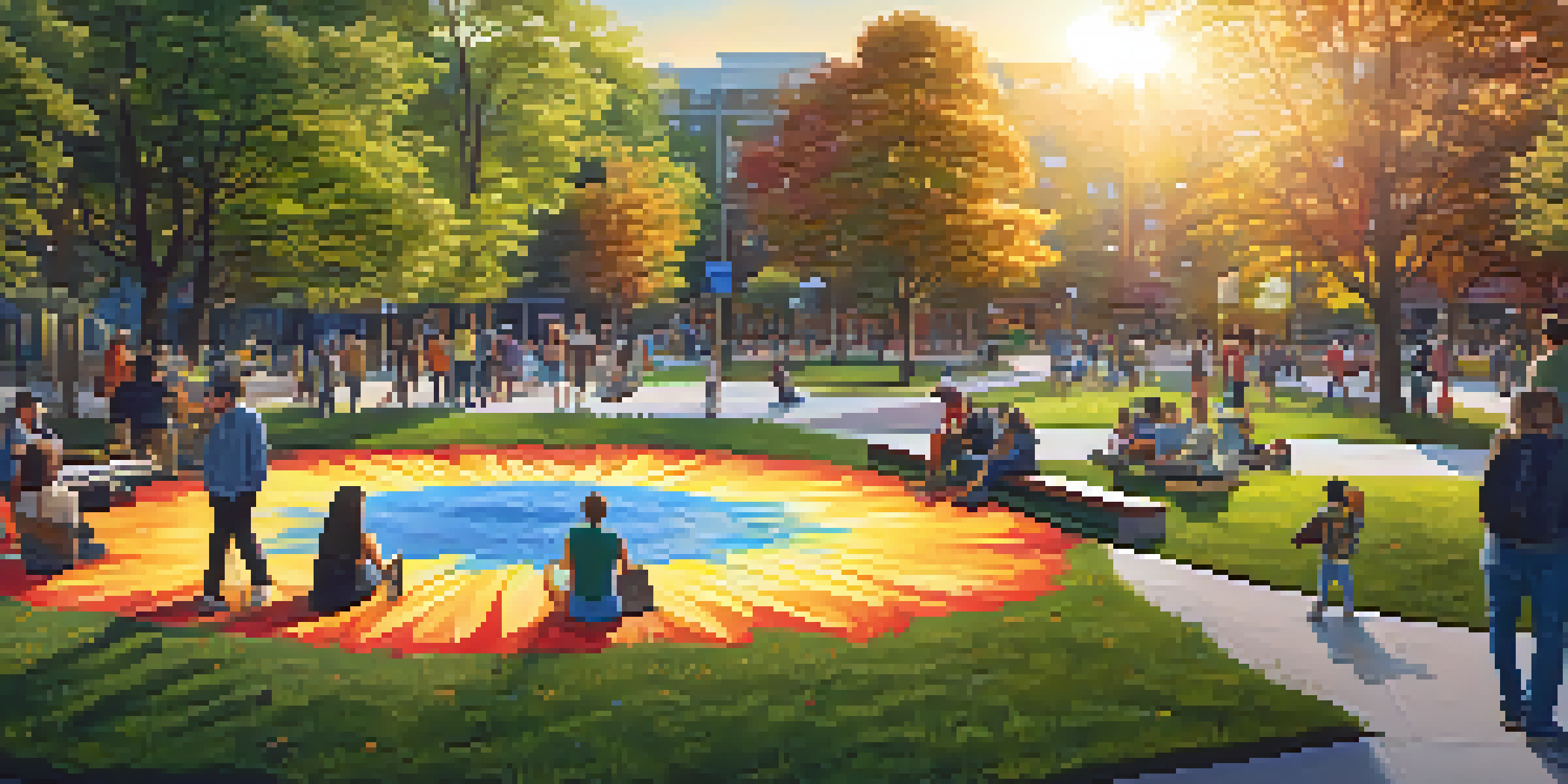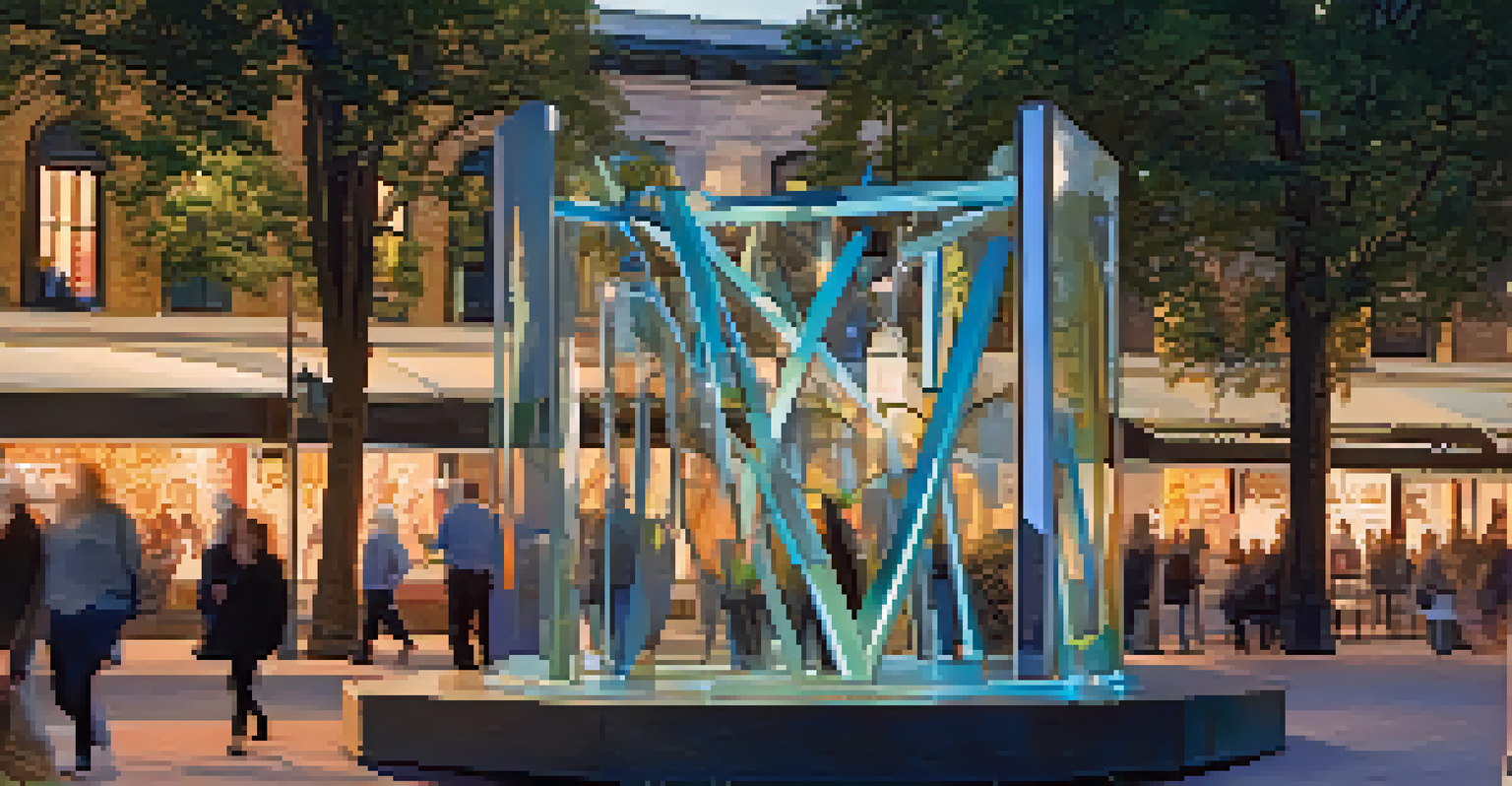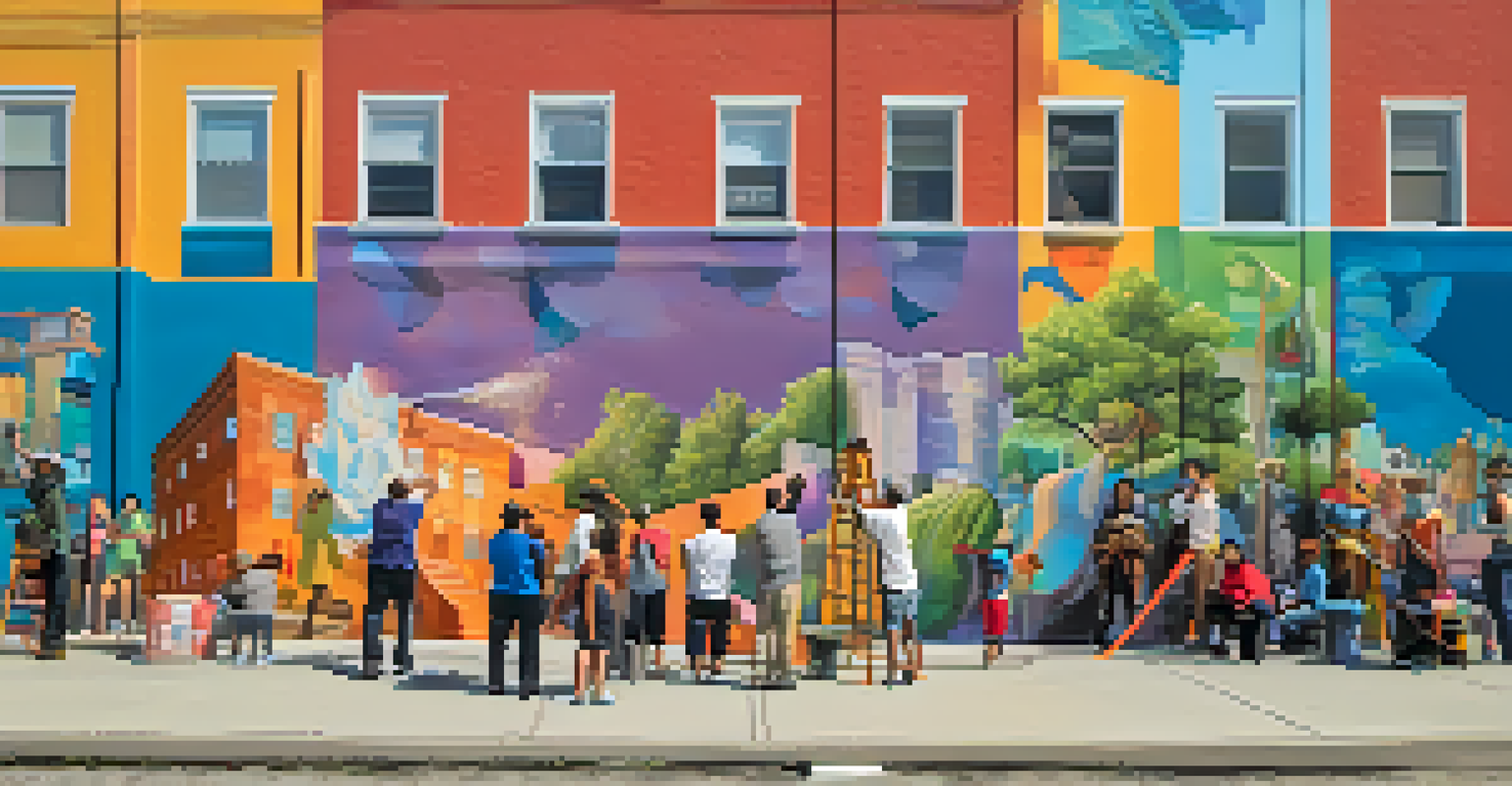The Role of Public Art Installations in City Identity Formation

Understanding Public Art Installations and Their Purpose
Public art installations are creative expressions placed in communal spaces, designed to engage and inspire the public. They can take many forms, from murals and sculptures to interactive installations that invite participation. The main purpose of these artworks is to enhance the aesthetic appeal of urban environments while fostering a sense of belonging among residents.
Public art is a way of making art accessible to everyone, allowing communities to share their stories and express their identities in public spaces.
By intertwining art with daily life, public installations create a unique narrative about the community's values, history, and aspirations. They often reflect the local culture and can become landmarks that residents and visitors alike recognize and cherish. This connection between art and place plays a significant role in how people perceive their city.
Ultimately, public art serves as a bridge between the past and present, allowing cities to express their identity in a dynamic and inclusive way. As communities evolve, so too do the stories told through these installations, making them a vital component of urban life.
How Public Art Contributes to City Identity Formation
City identity is shaped by various factors, and public art plays a crucial role in this process. Art installations can encapsulate the history and culture of a place, creating a visual representation of a city’s unique character. For example, a mural depicting local legends or historical events can serve as a reminder of the community's roots and aspirations.

Furthermore, public art fosters a sense of pride among residents, as they see their stories and cultures represented in the spaces they inhabit. This pride can encourage greater engagement with the city, leading to increased participation in local events and initiatives. As people connect with their environment, they contribute to a collective identity that enhances community bonds.
Public Art Enhances City Identity
Public art installations reflect a city's culture and history, fostering pride and a sense of belonging among residents.
Additionally, public art can attract tourists, who may come to see specific installations, thus boosting the local economy. This influx of visitors can further shape a city's identity as a vibrant, artistic destination, showcasing the talent and creativity of its residents.
Public Art as a Catalyst for Community Engagement
Public art installations often serve as catalysts for community engagement, inspiring dialogue and interaction among residents. When people encounter art in their everyday spaces, it can prompt conversations about shared experiences and local issues. This engagement can lead to a deeper understanding of community values and aspirations, fostering unity among diverse groups.
Art is not a thing; it is a way. It is a way of seeing, a way of feeling, a way of knowing, and a way of interacting with the world.
For instance, collaborative art projects, where community members contribute to the creation of a mural or sculpture, can enhance social cohesion. Participants not only leave their mark on the artwork but also build connections with their neighbors, creating a shared sense of ownership and pride. These projects often become focal points for community gatherings and celebrations, further strengthening relationships.
Moreover, public art can encourage civic participation by highlighting social issues and inspiring action. Art can be a powerful tool for advocacy, prompting discussions about inclusivity, diversity, and justice, thereby fostering a more engaged and informed citizenry.
The Impact of Public Art on Urban Aesthetics
One of the most visible impacts of public art is its contribution to urban aesthetics. Well-placed art installations can transform bland, neglected areas into vibrant spaces that draw people in. For example, a colorful mural on a previously dull building can breathe new life into a neighborhood, encouraging foot traffic and boosting local businesses.
Art can also serve to humanize urban spaces, making them more relatable and enjoyable for residents and visitors. By incorporating elements of nature or cultural motifs, public art helps create an environment that feels welcoming and engaging. This enhancement of the urban landscape can lead to a greater appreciation for the community among its inhabitants.
Art Fosters Community Engagement
Public art serves as a catalyst for dialogue and interaction, uniting diverse groups through shared creative experiences.
Furthermore, aesthetically pleasing environments can have positive effects on mental health and well-being. Studies suggest that exposure to art can reduce stress and promote feelings of happiness, contributing to a more vibrant city life.
Public Art and Cultural Representation
Public art can be a powerful vehicle for cultural representation, allowing diverse voices to be heard and celebrated. Installations can reflect the stories, struggles, and achievements of different communities, fostering a sense of belonging for marginalized groups. For instance, a sculpture honoring local indigenous history can serve as a reminder of a city's rich, multifaceted heritage.
By elevating underrepresented narratives, public art promotes inclusivity and diversity within the urban landscape. It encourages dialogue around cultural identity and can help bridge gaps between different demographic groups, fostering understanding and empathy. This representation is essential in creating a city that values all its residents and their contributions.
Moreover, public art can serve as a platform for artists from various backgrounds to share their perspectives, enriching the cultural fabric of the city. By creating space for these voices, cities can celebrate their diversity and cultivate a more robust, dynamic identity.
Challenges and Controversies Surrounding Public Art
While public art installations can significantly enhance city identity, they are not without challenges and controversies. Disputes often arise over the themes, styles, and funding of public artworks, with some community members questioning the relevance or appropriateness of certain pieces. These disagreements can spark heated debates about artistic freedom versus community values.
Moreover, the maintenance and preservation of public art can pose challenges for cities. Weathering, vandalism, and neglect can diminish the impact of these installations, leading to calls for restoration or removal. Ensuring that public art remains a vibrant part of the urban landscape requires ongoing investment and commitment from city officials and community members alike.
Challenges in Public Art Projects
Controversies and maintenance issues can complicate the role of public art in urban environments, necessitating careful community consideration.
Finally, issues of gentrification can complicate the role of public art in city identity. As neighborhoods evolve, the introduction of art installations may attract new residents and businesses, potentially displacing long-time community members. Balancing artistic expression with the needs of the existing community is a delicate task that requires thoughtful consideration.
The Future of Public Art in Urban Environments
As cities continue to grow and evolve, the future of public art looks promising yet challenging. With advancements in technology, we see innovative forms of public art emerging, such as digital installations and augmented reality experiences. These new mediums can engage audiences in exciting ways, inviting interaction and participation like never before.
Additionally, the growing emphasis on sustainability and environmental awareness is likely to influence public art projects. Artists may increasingly incorporate eco-friendly materials and practices, creating installations that not only beautify urban spaces but also promote environmental consciousness. This shift could lead to a new wave of public art that resonates with contemporary societal values.

Ultimately, the future of public art will depend on continued collaboration between artists, communities, and city officials. By fostering inclusive dialogues and prioritizing diverse perspectives, we can ensure that public art remains a vital component of urban identity, reflecting the rich tapestry of stories and experiences that define our cities.